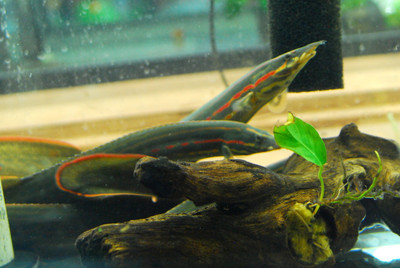Fire Eels
Posted by Max Gandara on on 26th Feb 2025
Fire Eels
Welcome to the captivating world of fire eels! If you are an aquarium enthusiast or simply curious about unique aquatic life, the fire eel is a creature worth exploring. In this blog, we will delve into the intriguing characteristics, care requirements, and interesting facts about these fascinating fish.
What is a Fire Eel?
The fire eel, scientifically known as Mastacembelus erythrotaenia, is a species of spiny eel that belongs to the family Mastacembelidae. Despite their name, they are not true eels but rather elongated fish. Native to Southeast Asia, fire eels can be found in the slow-moving rivers and streams of countries like Thailand, Malaysia, and Indonesia.
Distinctive Features
Fire eels are renowned for their striking appearance. They have long, slender bodies that can grow up to 40 inches (about 1 meter) in the wild, although they tend to be smaller in captivity. Their bodies are dark brown to black, adorned with vibrant red or orange stripes that run along their length, giving them their fiery name. These colors not only add to their beauty but also serve as camouflage in their natural habitat.
Habitat and Tank Requirements
Creating a comfortable environment for a fire eel in captivity requires careful consideration of their natural habitat:
-
Tank Size: Due to their size, a spacious aquarium is necessary. A minimum of 75 gallons is recommended for a single adult fire eel.
-
Water Conditions: Fire eels prefer warm, slightly acidic to neutral water. Maintain temperatures between 75-82°F (24-28°C), with a pH level of 6.5 to 7.5.
-
Substrate and Decor: A soft substrate like sand is ideal, as fire eels enjoy burrowing. Provide plenty of hiding spots with rocks, driftwood, and plants for them to feel secure.
-
Tank Mates: Fire eels are generally peaceful but can be territorial. They can coexist with other non-aggressive fish of similar size. Avoid small fish, as they might be seen as prey.
Diet and Feeding
Fire eels are carnivorous and thrive on a varied diet. In the wild, they feed on small fish, worms, and crustaceans. In captivity, they enjoy live or frozen foods such as bloodworms, brine shrimp, and small fish. Offering a mix of these foods will ensure they receive the necessary nutrients for healthy growth.
Behavior and Interaction
Fire eels are known for their shy and reclusive nature. They are nocturnal creatures, most active during the night. While they may initially be reserved, with time and patience, they can become more accustomed to their human caretakers. Some fire eels even learn to recognize their owners and will come out during feeding times.
Interesting Facts
-
Longevity: Fire eels can live for over a decade in captivity with proper care.
-
Electric Sense: Like other spiny eels, fire eels possess electroreceptors that help them detect prey in murky waters.
-
Escape Artists: Fire eels are notorious for trying to escape from aquariums. It's essential to have a secure lid to prevent any adventurous getaways.
Conclusion
Fire eels are a unique and striking addition to any aquarium, offering both aesthetic appeal and intriguing behavior. With the right environment and care, they can thrive and become an engaging part of your aquatic world. Whether you're a seasoned aquarist or a beginner, the fire eel's enchanting presence is sure to ignite your passion for fishkeeping.

